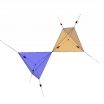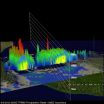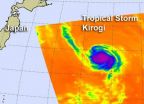(Press-News.org) A new 3-D view of the body's response to infection – and the ability to identify proteins involved in the response – could point to novel biomarkers and therapeutic agents for infectious diseases.
Vanderbilt University scientists in multiple disciplines combined magnetic resonance imaging (MRI) and imaging mass spectrometry to visualize the inflammatory response to a bacterial infection in mice. The techniques, described in Cell Host & Microbe and featured on the journal cover, offer opportunities for discovering proteins not previously implicated in the inflammatory response.
Access to unique resources at Vanderbilt made the unprecedented 3-D infection imaging possible, said Eric Skaar, Ph.D., Ernest Goodpasture Chair in Pathology and one of the senior co-authors of the paper.
"The studies in this paper couldn't have happened at any other university, because the resources simply don't exist at most schools," Skaar said.
The resources include animal imaging technologies available through the Vanderbilt University Institute of Imaging Science (VUIIS), directed by John Gore, Ph.D., and imaging mass spectrometry technologies available through the Mass Spectrometry Research Center (MSRC), directed by Richard Caprioli, Ph.D. Gore and Caprioli are also senior co-authors of the paper.
"The fact that my research group, which studies infectious diseases, has access to these powerful imaging and mass spectrometry technologies is a real strength at Vanderbilt and has allowed us to develop these new tools that will enable high impact discovery," Skaar said.
Skaar and his team were interested in imaging infection in three dimensions – in the whole animal – while also being able to identify the proteins that are produced at sites of infection. MRI provides detailed anatomical images of tissue damage. Imaging mass spectrometry is a unique technology that directly measures proteins, lipids and other metabolites and maps their distribution in a biopsy or other tissue sample.
Ahmed Attia, Ph.D., a former member of Skaar's group now on the faculty at Cairo University, Egypt, infected mice with Staphylococcus aureus, a major cause of human disease. He then delivered the infected animals to Daniel Colvin, Ph.D., in the VUIIS, who imaged them with MRI. Kaitlin Schroeder and Erin Seeley, Ph.D., in the MSRC then conducted imaging mass spectrometry studies. Putting together the two technologies and multiple data sets accurately required the expertise of Kevin Wilson, MESc, in the VUIIS, who developed algorithms to show consolidated 3-D views of the inflammatory response.
"This is another example of the multi-modality approach we have been pursuing in general within the Imaging Institute," Gore said.
The technologies allow the investigators to see a single image of an infected animal, look at how proteins of the immune system are responding, and identify where the infected tissue is located, Skaar said.
"Part of the strength of this work is not where the research is now, but where it allows us to go from here."
His team plans to identify "proteins that are important at the interface between the host and the pathogen – the battleground between the immune system and the bacteria," Skaar said. The researchers will study the proteins they identify to discover new biomarkers for infection, which could improve diagnostic tools, or new targets for therapeutic intervention.
The technologies available through the MSRC and the VUIIS will be useful for any investigator interested in imaging the inflammatory response, which has roles in infectious diseases, cancer and autoimmune diseases, Skaar said. And although the technology is not non-invasive (imaging mass spectrometry requires tissue sections), it could be applied to tissues removed from patients, such as tumors.
"Imaging mass spectrometry is extremely valuable for the discovery process because it does not require a target-specific reagent such as an antibody – that is, you do not have to know in advance what you're looking for in order to correlate molecular changes with disease outcome," Caprioli said. "An area of intense interest is the application of this technology to molecular pathology."
INFORMATION:
The research was supported by grants from the National Institutes of Health (AI069233, AI091771, AI073843, GM058008), the establishment of an NIH-funded National Resource for Imaging Mass Spectrometry, and a Pfizer 2009 ASPIRE research award. Skaar is a Burroughs Wellcome Fellow in the Pathogenesis of Infectious Diseases and is associate professor of Pathology, Microbiology and Immunology. Gore is University Professor of Radiology and Radiological Sciences and Hertha Ramsey Cress Chair in Medicine. Caprioli is Stanford Moore Chair in Biochemistry.
Team creates new view of body's infection response
2012-08-10
ELSE PRESS RELEASES FROM THIS DATE:
The earthquake risk and Europe
2012-08-10
How strong can earthquakes in Germany be? Where in Europa are the earthquake activities concentrated? These questions are the basis for risk assessments and become relevant when it comes to the safety of buildings or the generation of tsunami.For the first time, scientists of the GFZ German Research Centre for Geosciences have succeeded in setting up a harmonized catalogue of earthquakes for Europe and the Mediterranean for the last thousand years. This catalogue consists of about 45000 earthquakes, reported in the latest issue of the „Journal of Seismology".
Earthquakes ...
Researchers combine remote sensing technologies for highly detailed look at coastal change
2012-08-10
Athens, Ga. – Shifting sands and tides make it difficult to measure accurately the amount of beach that's available for recreation, development and conservation, but a team of University of Georgia researchers has combined several remote sensing technologies with historical data to create coastal maps with an unsurpassed level of accuracy.
In a study published in the August issue of the journal Tourism Management, they apply their technique to Georgia's Jekyll Island and unveil a new website that allows developers, conservationists and tourists access to maps and data ...
Hepatitis A vaccination in children under 2 remains effective for 10 years
2012-08-10
Vaccination against the hepatitis A virus (HAV) in children two years of age and younger remains effective for at least ten years, according to new research available in the August issue of Hepatology, a journal of the American Association for the Study of Liver Diseases (AASLD). The study found that any transfer of the mother's HAV antibodies does not lower the child's immune response to the vaccine.
The World Health Organization (WHO) estimates that 1.4 million cases of HAV occur worldwide each year. HAV affects the liver and typically occurs in areas with poor sanitation ...
Why living in the moment is impossible
2012-08-10
The sought-after equanimity of "living in the moment" may be impossible, according to neuroscientists who've pinpointed a brain area responsible for using past decisions and outcomes to guide future behavior. The study, based on research conducted at the University of Pittsburgh and published today in the professional journal Neuron, is the first of its kind to analyze signals associated with metacognition—a person's ability to monitor and control cognition (a term cleverly described by researchers as "thinking about thinking.")
"The brain has to keep track of decisions ...
Freezing magnetic monopoles
2012-08-10
Magnetic monopoles, entities with isolated north or south magnetic poles, weren't supposed to exist. If you try to saw a bar magnet in half, all you succeed in getting are two magnets, each with a south and north pole. In recent years, however, the existence of monopoles, at least in the form of "quasiparticles" consisting of collective excitations among many atoms, has been predicted and demonstrated in the lab. Now Stephen Powell, a scientist at the Joint Quantum Institute (JQI*) and the University of Maryland, has sharpened the theoretical framework under which ...
NASA sees very heavy rainfall within Tropical Storm Ernesto
2012-08-10
NASA's Tropical Rainfall Measuring Mission satellite, known as TRMM can measure the rate rain is falling with a tropical cyclone from its orbit in space, and data from August 9 reveals areas of heavy rainfall in Tropical Storm Ernesto as it heads for a second landfall in Mexico.
The TRMM satellite saw tropical storm Ernesto on August 9, 2012 at 0656 UTC (2:36 a.m. EDT) after it moved from the Yucatan Peninsula into the Gulf of Mexico. An analysis of TRMM Microwave Imager (TMI) and Precipitation Radar (PR) rainfall shows that powerful convective thunderstorms were dropping ...
NASA sees Tropical Storm Kirogi headed for cooler waters
2012-08-10
Sea surface temperatures cooler than 80 degrees Fahrenheit can sap the strength from a tropical cyclone and Tropical Storm Kirogi is headed toward waters below that threshold on its track through the northwestern Pacific Ocean, according to data from NASA's Aqua satellite.
NASA's Aqua satellite passed over Tropical Storm Kirogi on August 9 at 0241 UTC. The Atmospheric Infrared Sounder (AIRS) instrument captured an infrared image of the cloud temperatures that showed a concentrated area of strongest storms and heaviest rainfall west of the center of circulation. Vertical ...
Height, weight and BMI changes seen in children treated with peginterferon alpha for hepatitis C
2012-08-10
Follow-up research from the Pediatric Study of Hepatitis C (PEDS-C) trial reveals that children treated with peginterferon alpha (pegIFNα) for hepatitis C (HCV) display significant changes in height, weight, body mass index (BMI), and body composition. Results appearing in the August issue of Hepatology, a journal of the American Association for the Study of Liver Diseases, indicate that most growth-related side effects are reversible with cessation of therapy. However, in many children the height-for-age score had not returned to baseline two years after stopping ...
BUSM/VA researchers uncover gender differences in the effects of long-term alcoholism
2012-08-10
(Boston) – Researchers from Boston University School of Medicine (BUSM) and Veterans Affairs (VA) Boston Healthcare System have demonstrated that the effects on white matter brain volume from long-term alcohol abuse are different for men and women. The study, which is published online in Alcoholism: Clinical and Experimental Research, also suggests that with abstinence, women recover their white matter brain volume more quickly than men.
The study was led by Susan Mosher Ruiz, PhD, postdoctoral research scientist in the Laboratory for Neuropsychology at BUSM and research ...
Soft autonomous robot inches along like an earthworm
2012-08-10
CAMBRIDGE, MA -- Earthworms creep along the ground by alternately squeezing and stretching muscles along the length of their bodies, inching forward with each wave of contractions. Snails and sea cucumbers also use this mechanism, called peristalsis, to get around, and our own gastrointestinal tracts operate by a similar action, squeezing muscles along the esophagus to push food to the stomach.
Now researchers at MIT, Harvard University and Seoul National University have engineered a soft autonomous robot that moves via peristalsis, crawling across surfaces by contracting ...



